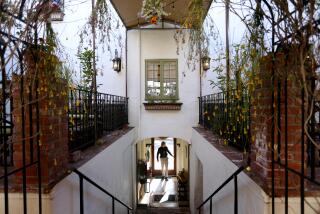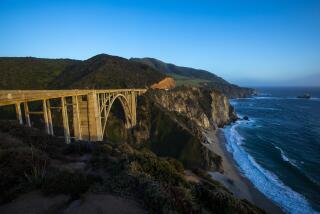S.F. Bay Island Restoration Plan in Red Tape Quagmire
BAIR ISLAND â Visible for a two-mile stretch along U.S. 101 south of the San Mateo Bridge, Bair Island--3,200 acres of marsh, sloughs and abandoned salt ponds thrusting into the San Francisco Bay--isnât much to look at.
Devoid of trees, the prettiest part of the island is dominated by thick, ground-hugging pickleweed. The uglier parts--where commercial salt mining went on for decades--have been likened to a moonscape.
But this unattractive hump also is the largest chunk of easily restorable wetlands left on the south end of the nationâs most urbanized bay. For that reason, it has for decades been a prize fought over by would-be developers and determined conservationists.
Piece by piece, the state and federal governments bought the outer 1,574 acres of the island between 1974 and 1980. The federal Fish and Wildlife Service then turned it into a federal wildlife refuge by opening the levees that held back the sea and re-flooding the salt ponds.
The remaining 1,626 acres--just offshore from Redwood City--were bought and sold by a succession of development firms, each of which found a wall of opposition from conservationists to building on the island.
Then, last year, in what environmentalists hailed as a major victory for endangered bay wildlife, a local nonprofit group bought the remaining 1,626 acres for $15 million.
That was supposed to be the happy ending to the Bair Island saga. But for reasons that have everything to do with the misplaced optimism of a well-meaning conservation group and the byzantine nature of Washington politics--and very little to do with Bair Islandâs merits as a wildlife refuge--the happy ending has yet to be written.
The Peninsula Open Space Trust, which borrowed most of the money to buy the island, planned to quickly resell it to a federal government that had identified the island as a top purchase priority and indicated it would be willing to buy it back. The trust also planned to create a visitor area near the shore and to help rapidly restore the wetlands by breaching the remaining levees.
All that was needed was a $10-million appropriation from Congress to pay back the loans the trust took out to make the below-market-value purchase it had negotiated. The trust raised most of the other $5 million from private donors.
Audrey Rust, the trustâs executive director, said the group expected the appropriation for Bair Island to be made last fall, or this fall at the latest, from money that the federal government sets aside each year from offshore oil leases to purchase public lands.
Identified by the Fish and Wildlife Service in 1985 as essential to the recovery of the endangered clapper rail, the island was listed by the service as a top priority for acquisition, but there was no money to buy it. Rust said she expected the purchase to win bipartisan support in Congress.
But bipartisan sentiment is hard to find on Capitol Hill these days. This month, money to purchase Bair Island got bogged down in bickering between the interior and appropriations committees. Local congressional representatives who are lobbying for the money are Democrats, Rust said. Republicans control the committees.
So the trust has been left with $300,000 annual loan payments--a stretch for an organization with a $1.5-million annual budget.
That is the risk nonprofit organizations always take when they make such a purchase, because the federal government never commits in advance to coming through with the money, said Jean Hocker, president of the Land Trust Alliance, an umbrella organization in Washington that represents hundreds of land trusts across the nation.
âYouâre always dependent on appropriations for your project,â Hocker said. Because of the risk involved, âvery few land trusts are in a position to take on a project the scale of Bair Island,â she said. âMost are smaller organizations than [Peninsula Open Space Trust]. Many just operate with privately donated funds and depend on gifts of land or conservation easements to make acquisitions.â
Although the Peninsula trust has made large purchases in the past that involved some state and federal funding, Rust said, it has never faced such a nerve-racking delay in expected reimbursement.
âWe feel quite strung out about this situation, I would say,â Rust said. âWe are still in debt to the tune of $10 million, and that puts us in a high-risk situation.â
Congress now is considering an appropriations bill that would authorize $3.5 million for Bair Island this year, Rust said. Even if that passes, it will force the trust to keep servicing a considerable chunk of debt for at least another year, possibly more, as it waits for more congressional funds to come its way.
But loan payments arenât the only problem. As long as the trust owns the island, it must pay about $60,000 a year for mosquito abatement. It must also mount security patrols and carry insurance on the property, Rust said.
And because the value of the land must be maintained until the loans are paid off, the trust also cannot breach the levees and re-flood stretches of the land.
âIt is frustrating,â Rust said. âWeâre holding this land, which canât be restored as long as we hold it, and we know that every year that passes is another breeding season for these endangered species that would be benefited if we restored it.â
In the trustâs 20 years of buying land to protect it from development, it has never found itself in such a bind before, Rust said.
Still, she said, âwe will not give up.â Trust officials have come close to âwearing out our welcomeâ on Capitol Hill, she said. The trust has organized letter writing campaigns supporting Bair Island and buttonholed members of Congress. They have hosted congressional tours of the island and pestered donors to lobby key committee members.
A boat trip through the islandâs sloughs underscores what they are fighting for.
Within sight of the busy U.S. 101, shy harbor seals slip along the narrow channels that cut across the island, hauling out on dry land to sun themselves. This is one of just three sites in the bay where harbor seals pup.
Snowy egrets stroll in the shallower sloughs, expertly spearing fish. Dozens of breeds of birds nest in the pickleweed and hunt here. Velvety black bat rays and spotted leopard sharks gobble fingerlings hatched in the sloughs.
âMost of the wetlands that we have left in the bay are thin, narrow strips of wetlands along the outside of levees,â said Marge Kolar, director of the Don Edwards San Francisco Bay National Wildlife Refuge.
âThe endangered species that live in them are very vulnerable to predators. If you have a big, large area, it allows the animals in the center to be undisturbed. That is why this particular property is so valuable,â Kolar said.
Rust got a phone call in the fall of 1996 from an attorney representing the Kumagai Gumi Co. Ltd., the Japanese firm that then owned the island. Since 1983, she said, her trust and other organizations had tried to negotiate a purchase, but talks with the islandâs various owners had never gone anywhere. After it bought the island from Mobil Oil in 1989, Kumagai Gumi did not seem determined to develop the island.
By late 1996, the Japanese economy was in recession and national environmental organizations like the Sierra Club had rallied to the cause of preserving Bair Island. By January 1997, the trust had cut a deal with Kumagai Gumi to buy Bair Island. The trust took possession that May.
In 15 years of preserving mountain and coastal properties and farmland, the trust has made larger purchases than Bair Island, Rust said. But it has never made one as significant as this remnant of what once were hundreds of thousands of acres of wetlands around the bay.
âMany areas around the bay have subsided where people have built levees,â said Kolar, the refuge manager. âEven if you buy that property and break the levees, youâll have a big lake for 20 or 30 years until the sediment builds up enough. In Bair Island, the land is not very subsided. In four to five years after breaking the levees, we could get those wetlands back.â
More to Read
Sign up for Essential California
The most important California stories and recommendations in your inbox every morning.
You may occasionally receive promotional content from the Los Angeles Times.










